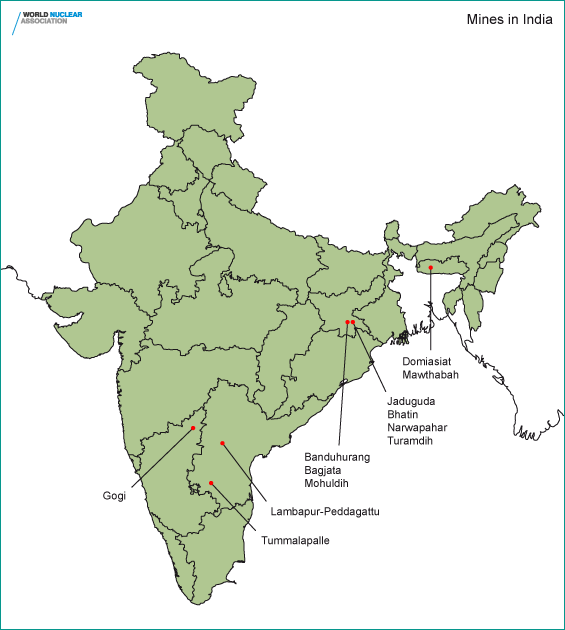Wednesday, July 6, 2011
Uranium resources in India
India's uranium resources are modest, with 73,000 tonnes U as reasonably assured resources (RAR) and 33,000 tonnes as inferred resources in situ (to $130/kgU) at January 2009. Accordingly, from 2009 India is expecting to import an increasing proportion of its uranium fuel needs.
Mining and processing of uranium is carried out by Uranium Corporation of India Ltd, a subsidiary of the Department of Atomic Energy (DAE), at Jaduguda and Bhatin (since 1967), Narwapahar (since 1995) and Turamdih (since 2002) - all in Jharkhand near Calcutta. All are underground, the last two being modern. A common mill is located near Jaduguda, and processes 2090 tonnes per day of ore.
In 2005 and 2006 plans were announced to invest almost US$ 700 million to open further mines in Jharkand at Banduhurang, Bagjata and Mohuldih; in Meghalaya at Domiasiat-Mawthabah (with a mill) and in Andhra Pradesh at Lambapur-Peddagattu (with mill 50km away at Seripally), both in Nalgonda district.
In Jharkand, Banduhurang is India's first open cut mine and was commissioned in 2007. Bagjata is underground and was opened in December 2008, though there had been earlier small operations 1986-91. The Mohuldih underground mine is expected to operate from 2010. A new mill at Turamdih in Jharkhand, with 3000 t/day capacity, was commissioned in 2008.
In Andhra Pradesh there are three kinds of uranium mineralisation in the Cuddapah Basin, including unconformity-related deposits in the north of it. The northern Lambapur-Peddagattu project in Nalgonda district 110 km southeast of Hyderabad has environmental clearance for one open cut and three small underground mines (based on some 6000 tU resources at about 0.1%U) but faces local opposition. In August 2007 the government approved a new US$ 270 million underground mine and mill at Tummalapalle near Pulivendula in Kadapa district, at the south end of the Basin and 300 km south of Hyderabad, for commissioning in 2010. Its resources have been revised upwards to 40,000 tU and first production is expected early in 2012, using alkaline leaching for the first time in India. A further northern deposit near Lambapur-Peddagattu is Koppunuru, in Guntur district.
In Meghalaya, close to the Bangladesh border in the West Khasi Hills, the Domiasiat-Mawthabah mine project (near Nongbah-Jynrin) is in a high rainfall area and has also faced longstanding local opposition partly related to land acquisition issues but also fanned by a campaign of fearmongering. For this reason, and despite clear state government support in principle, UCIL does not yet have approval from the state government for the open cut mine at Kylleng-Pyndeng-Shahiong (also known as Kylleng-Pyndengshohiong-Mawthabah and formerly as Domiasiat) though pre-project development has been authorised on 422 ha. However, federal environmental approval in December 2007 for a proposed uranium mine and processing plant here and for the Nongstin mine has been reported. There is sometimes violent opposition by NGOs to uranium mine development in the West Khasi Hills, including at Domiasiat and Wakhyn, which have estimated resources of 9500 tU and 4000 tU respectively. Tyrnai is a smaller deposit in the area. The status and geography of all these is not known.
In Karnataka, UCIL is planning a small uranium mine at Gogi in Gulbarga area from about 2012, after undertaking a feasibility study. A mill is planned for Diggi nearby. Total cost is about $122 million. Resources are sufficient for 15 years mine life, but UCIL plans also to utilise the uranium deposits in the Bhima belt from Sedam in Gulbarga to Muddebihal in Bijapur.
Labels:
GEOGRAPHY
Subscribe to:
Post Comments (Atom)


No comments:
Post a Comment